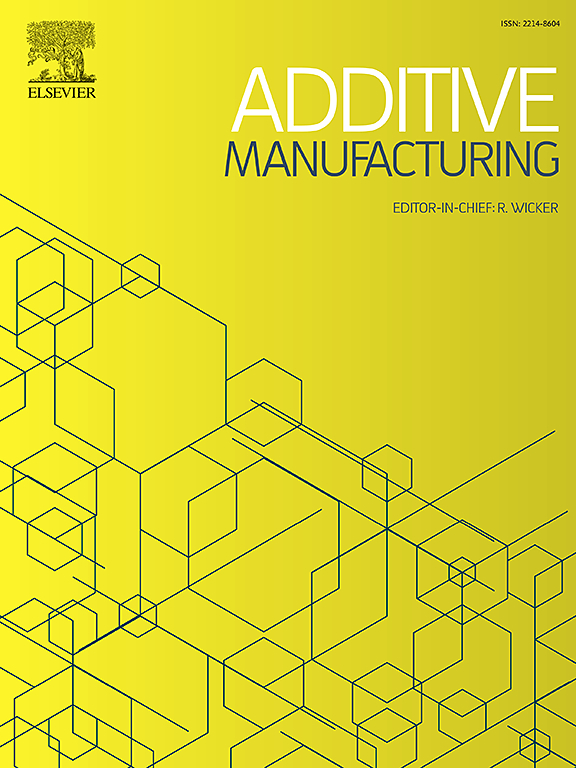面向增材制造的固体-晶格混合结构数据驱动多尺度拓扑优化
IF 11.1
1区 工程技术
Q1 ENGINEERING, MANUFACTURING
引用次数: 0
摘要
与纯固体或晶格结构相比,固体-晶格混合结构提供了更高的力学性能,有效地平衡了各种设计要求。本文提出了一种数据驱动的多尺度拓扑优化方法,用于设计适合增材制造的固体-晶格混合结构。采用隐式建模技术构建微观结构模型,实现微观结构单元的力学表征和优化设计的几何重构。创建一个示例数据库和代理模型来加速优化过程。实体和晶格结构由两组密度变量表示,分别定义在实体和晶格层网格上。此外,引入Heaviside函数作为密度滤波的投影函数,从实体层网格中去除伪密度元素。在优化过程中,采用了两个体积约束来调节结构的形态和性能。优化后,采用混合水平集法(HLSM)将拓扑优化后的固体结构与梯度晶格结构相结合,重构全尺寸的固体-晶格混合结构。通过二维和三维数值算例验证了该方法的有效性。最后,采用增材制造技术对优化后的结构进行了加工,并通过有限元分析和实验测试对优化后的结构进行了性能验证。结果证实了整体力学性能的显著改善,突出了所提出的方法在设计轻质、高性能结构方面的有效性。本文章由计算机程序翻译,如有差异,请以英文原文为准。
Data-driven multiscale topology optimization of solid-lattice hybrid structures for additive manufacturing
Compared to pure solid or lattice structures, solid-lattice hybrid structures offer enhanced mechanical performance, effectively balancing various design requirements. In this paper, a data-driven multiscale topology optimization method is proposed for designing solid-lattice hybrid structures tailored for additive manufacturing. Implicit modeling techniques are employed to construct microstructure models, enabling both mechanical characterization of microstructure unit cells and geometric reconstruction of optimized designs. A sample database and surrogate model are created to accelerate the optimization process. The solid and lattice structures are represented by two sets of density variables, defined on the solid and lattice layer meshes, respectively. Additionally, the Heaviside function is introduced as a projection function for density filtering, removing pseudo-density elements from the solid layer mesh. Two volume constraints are applied to regulate the structural configuration and performance during the optimization process. After optimization, full-scale solid-lattice hybrid structures are reconstructed by combining topologically optimized solid structures with graded lattice structures using the hybrid level set method (HLSM). Several 2D and 3D numerical examples are provided to validate the effectiveness of the proposed method. Finally, the optimized structures are fabricated via additive manufacturing (AM), and their performance is validated through both finite element analysis (FEA) and experimental testing. The results confirm notable improvements in overall mechanical performance, highlighting the effectiveness of the proposed method in designing lightweight, high-performance structures.
求助全文
通过发布文献求助,成功后即可免费获取论文全文。
去求助
来源期刊

Additive manufacturing
Materials Science-General Materials Science
CiteScore
19.80
自引率
12.70%
发文量
648
审稿时长
35 days
期刊介绍:
Additive Manufacturing stands as a peer-reviewed journal dedicated to delivering high-quality research papers and reviews in the field of additive manufacturing, serving both academia and industry leaders. The journal's objective is to recognize the innovative essence of additive manufacturing and its diverse applications, providing a comprehensive overview of current developments and future prospects.
The transformative potential of additive manufacturing technologies in product design and manufacturing is poised to disrupt traditional approaches. In response to this paradigm shift, a distinctive and comprehensive publication outlet was essential. Additive Manufacturing fulfills this need, offering a platform for engineers, materials scientists, and practitioners across academia and various industries to document and share innovations in these evolving technologies.
 求助内容:
求助内容: 应助结果提醒方式:
应助结果提醒方式:


